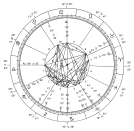Orb (astrology)
| Astrology |
|---|
 New millennium astrological chart |
| Background |
| Traditions |
| Branches |
|
|
In astrology, the orb is how much an angle made by two points differs from the exactness of an aspect. A trine, for instance, is 120 degrees. If two points were 123 degrees apart, they would be said to be in a trine with an orb of 3 degrees. It is generally held in astrological delineation that the larger the orb, the less powerful the aspect's effect is.
For example, if the sun is located in the sign Aquarius at 15 degrees and the moon is also going through Aquarius, then the moon's orb of influence will begin no earlier than 5 degrees Aquarius and will last no longer than 25 degrees Aquarius. However, this would be considered a wide orb. Most astrologers consider the orb of influence to be no more than 8 degrees on either side.
Larger orbs tend to be used for aspects involving major bodies, such as the sun or moon. Larger orbs also tend to be used for major aspects, such as conjunctions and oppositions.
Smaller orbs are sometimes used when an aspect is "out of sign". An "out of sign" aspect involves one that is a multiple of 30 degrees, meaning the two points should have the same positioning within their signs, however the orb causes the points to be in different signs than expected. For example, if the sun is located at 29 degrees Aries, and the moon is located at 1 degree Leo, the difference is 92 degrees, which makes a square aspect. However Aries and Leo are four signs or 120 degrees apart, so one might expect a trine aspect instead when just considering the signs involved.